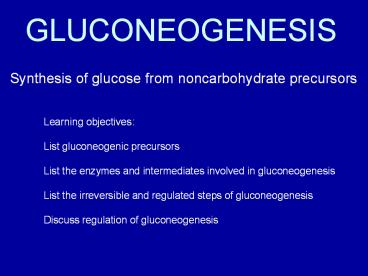GLUCONEOGENESIS - PowerPoint PPT Presentation
Title:
GLUCONEOGENESIS
Description:
... involved in gluconeogenesis. List the irreversible and regulated steps of gluconeogenesis ... Allosteric regulator of glycolysis and gluconeogenesis ... – PowerPoint PPT presentation
Number of Views:1531
Avg rating:3.0/5.0
Title: GLUCONEOGENESIS
1
GLUCONEOGENESIS
Synthesis of glucose from noncarbohydrate
precursors
Learning objectives List gluconeogenic
precursors List the enzymes and intermediates
involved in gluconeogenesis List the
irreversible and regulated steps of
gluconeogenesis Discuss regulation of
gluconeogenesis
2
Gluconeogenic precursors
- 18 amino acids
- (diet and degradation of protein)
- Lactate
- (anaerobic glycolysis)
- Glycerol
- (hydrolysis of triacylglycerols)
Notable exception Fatty acids
3
Gluconeogenic precursors
Lactate and some amino acids can be converted to
pyruvate Some amino acids can be converted to
oxaloacetate Glycerol can be converted to
dihydroxyacetone phosphate
4
Gluconeogenic pathway describes conversion of
pyruvate to glucose Main organs producing
glucose via the gluconeogenic pathway are liver
and kidney
5
Gluconeogenic pathway is NOT a simple reversal of
glycolysis
The 3 irreversible steps of glycolysis Hexokinase
/Glucokinase Phosphofructokinase Pyruvate
kinase must be circumvented The 7 reversible
steps of glycolysis are part of gluconeogenesis
6
All the intermediates of glycolysis are part
of gluconeogenesis In addition, gluconeogenesis
involves oxaloacetate and (indirectly) malate
O O- C C O CH2
C O O-
O O- C H C OH CH2
C O O-
Oxaloacate
Malate
7
Stoichiometry 2 Pyruvate 4 ATP 2 GTP 2
NADH 2 H 6 H2O ? 1 Glucose 4 ADP 2 GDP
6 Pi 2 NAD
8
Pyruvate carboxylase
Pyruvate CO2 ATP H2O
Oxaloacetate ADP Pi 2 H
This reaction occurs in the mitochondria It is a
regulated step Biotin is a coenzyme for the
reaction
9
Pyruvate is transported from the cytoplasm to the
mitochondria. In the mitochondria, pyruvate is
converted to oxaloacetate by pyruvate
carboxylase Oxaloacetate can not be transported
to the cytoplasm. Oxaloacetate is reduced in the
mitochondria to malate
Malate dehydrogenase Oxaloace
tate NADH H
Malate NAD Malate is transported to the
cytoplasm and reoxidized back to oxaloacetate
Malate
dehydrogenase Malate NAD
Oxaloacetate
NADH H
10
Phosphoenolpyruvate carboxykinase (PEPCK)
Oxaloacetate GTP
Phosphoenolpyruvate GDP CO2
It is a regulated step
11
Fructose-1,6- bisphosphatase
Fructose 1,6-bisphosphate H2O
Fructose 6-phosphate Pi
Irreversible Regulated step
12
Glucose-6-phosphatase
Glucose 6-phosphate H2O
Glucose Pi
Irreversible Regulated step Only present in large
amount in liver and kidney Reaction occurs in the
endoplasmic reticulum
13
(No Transcript)
14
Glycerol kinase
Glycerol ATP
Glycerol phosphate ADP H
Glycerol phosphate dehydrogenase
Glycerol phosphate NAD
Dihydroxyacetone phosphate NADH H
15
Pyruvate carboxylase
Pyruvate CO2 ATP H2O
Oxaloacetate ADP Pi 2 H
Acetyl CoA (High energy signal)
LIVER IN THE FASTED STATE
Energy is derived mostly from fatty acids
Acetyl-CoA
Pyruvate dehydrogenase
Fatty acids
-
Pyruvate
Oxaloacetate
Pyruvate carboxylase
16
Phosphoenolpyruvate carboxykinase (PEPCK)
Oxaloacetate GTP
Phosphoenolpyruvate GDP CO2
Phosphoenolpyruvate carboxykinase is regulated at
the level of gene transcription
Glucagon, glucocorticoids (fasted state) Insulin
(fed state)
-
17
Fructose-1,6- bisphosphatase
Fructose 1,6-bisphosphate H2O
Fructose 6-phosphate Pi
AMP (low-energy state) Fructose 2,6-bisphosphate
(fed state, high insulin/glucagon ratio) ATP
(high-energy state)
-
-
18
Glucose-6-phosphatase
Glucose 6-phosphate H2O
Glucose Pi
The catalytic subunit of glucose-6-phosphatase is
regulated at the level of gene transcription
Glucagon, glucocorticoids (fasted state) Insulin
(fed state) Glucose (fed state) - Paradoxical
regulation
-
19
Glycolysis
Gluconeogenesis
Glucokinase
Glucose
Insulin Glucose
Glucose-6-phosphatase
Insulin Glucagon Glucose
-
Glucose-6-phosphate
20
Glycolysis
Gluconeogenesis
Phosphofructokinase
Fructose 6-phosphate
Fructose-1,6- bisphosphatase
ATP Fructose 2,6-bisphosphate AMP
ATP Citrate H Fructose 2,6-bisphosphate AMP
-
-
-
Fructose 1,6-bisphosphate
-
-
21
Glycolysis
Gluconeogenesis
Pyruvate kinase
PEPCK
Phosphoenolpyruate
-
Glucagon Insulin Acetyl-CoA
Glucagon ATP Alanine Fructose
1,6-bisphosphate Glucose
-
-
Pyruvate carboxylase
-
Pyruvate
22
Allosteric regulator of glycolysis and
gluconeogenesis
Fructose 2,6-bisphosphate
Phosphofructokinase 2
Fructose 6-phosphate ATP
Fructose 2,6-bisphosphate ADP
Fructose bisphosphatase 2
Fructose 2,6-bisphosphate H2O
Fructose 6-phosphate Pi
23
G-6-P
F-6-P
PFK 2
FBPase 2
F-2,6-P2
-
FBPase 1
PFK 1
-1,6-P
F
2
PK
The PFK2 and FBPase 2 activities are located in a
single protein The bifunctional enzyme
24
Fasted state High Glucagon -gt High cAMP -gt
activation of PKA -gt phosphorylation of
bifunctional enzyme -gt inhibition of PFK2,
activation of FBPase2 -gt decrease in fructose
2,6-bisphosphate -gt no stimulation of glycolysis,
no inhibition of gluconeogenesis -gt
Gluconeogenesis prevails! Fed state Low
Glucagon -gt No/Low cAMP -gt no activation of PKA
-gt dephosphorylation of bifunctional enzyme
prevails -gt activation of PFK2, inhibition of
FBPase2 -gt increase in fructose 2,6-bisphosphate
-gt stimulation of glycolysis, inhibition of
gluconeogenesis -gt Glycolysis prevails!
25
The Cori cycle
Blood- stream
LIVER
MUSCLE
Glucose Lactate
Glucose Lactate
Gluconeogenesis
Glycolysis































